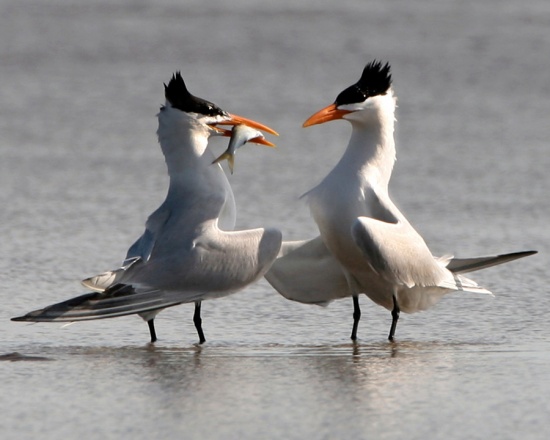- Thalasseus maximus
Sterna maxima
Identification
Length 45–51 cm (17¾-20 in), wingspan 100-135 cm, weight 320-500 g
- Long orange bill (variable between yellowish-orange to reddish-orange, but never black-tipped)
- Pale grey upperparts
- White underparts, including all except tips of primaries in underwing
- Black legs
- Noticeable shaggy black crest; full black crown only in spring at the start of the breeding season (February to May or June).
- From summer to winter, the black crown recedes to leave a white forecrown
- Juvenile mottled with pale sandy brown above
Similar Species
- Caspian Tern is substantially larger, with a heavy red bill with blackish tip, less shaggy crest, and primary feathers with dark undersides.
- Lesser Crested Tern is slightly smaller and with a slimmer bill, and in close views, with a pale grey (not white) rump.
- Elegant Tern is also slightly smaller and with a slimmer, slightly downcurved bill; it holds full black crown later into the summer (to late July to August).
Distribution

SFF Los Flamencos (Los Flamencos Sanctuary)
Desembocadura de Ciénaga del Navío Quebrado (La Guajira/Colombia), 23 November 2023
Warm temperate to tropical coasts of North America, Central America, South America, and the West Indies.
Resident or short-distance migrant: on the Atlantic side reaches south to the Guianas, Brazil and south-central Argentina; on the Pacific coast from southern California south to Peru
Is also dispersive, particularly northward in late summer on the Atlantic coast of North America, north to Nova Scotia, rarely even Newfoundland.
Very rare vagrant to western Europe. Unlike Caspian Tern, extremely rare inland.
Taxonomy
This is a monotypic species[1].
West African Crested Tern was formerly included in Royal Tern.
Like other Thalasseus terns, the Royal Tern was formerly often placed in the genus Sterna.
Habitat
Coasts and islands.
Behaviour
Breeding
They nest in a ground scrape and lays 1-2 eggs.
Diet
They feed by plunge-diving for fish.
Vocalisation
Call: krryuk or kree-it
Reference
- Clements, J. F., T. S. Schulenberg, M. J. Iliff, S. M. Billerman, T. A. Fredericks, J. A. Gerbracht, D. Lepage, B. L. Sullivan, and C. L. Wood. 2021. The eBird/Clements checklist of Birds of the World: v2021. Downloaded from https://www.birds.cornell.edu/clementschecklist/download/
- Handbook of the Birds of the World Alive (retrieved August 2016)
- Collins Field Guide 5th Edition
- Collins Bird Guide ISBN 0 00 219728 6
- Wikipedia
Recommended Citation
- BirdForum Opus contributors. (2024) Royal Tern. In: BirdForum, the forum for wild birds and birding. Retrieved 27 April 2024 from https://www.birdforum.net/opus/Royal_Tern
External Links
GSearch checked for 2020 platform.1






